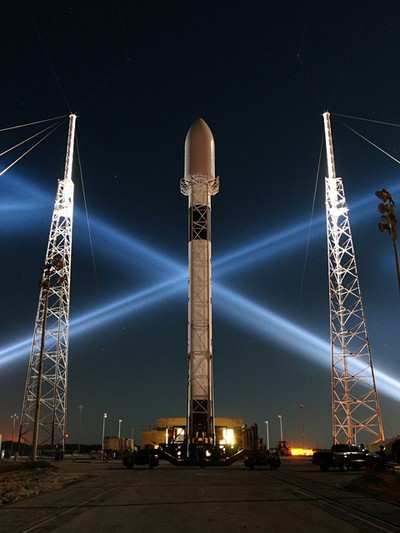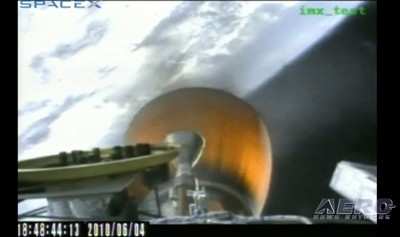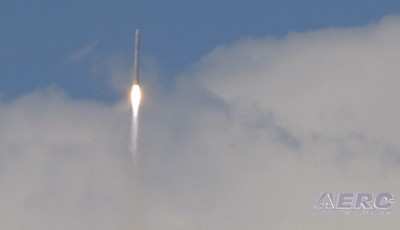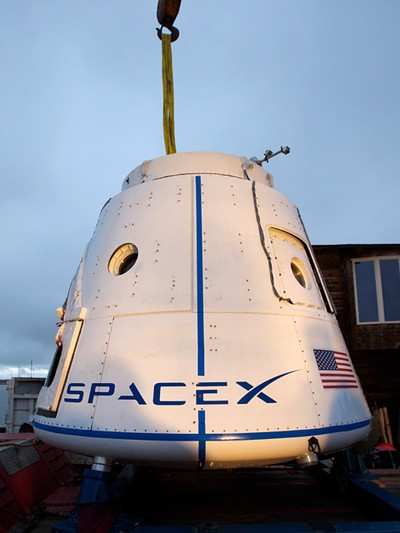Sat, Dec 04, 2010
Static Firing Was Aborted 1.1 Seconds Into A Planned 3 Second
Burn
By Wes Oleszewski
Friday morning SpaceX's second Falcon 9 launch vehicle attempted
a static firing test at Cape Canaveral's Launch Complex 40 in
preparation for a December 7th launch. That launch will be the
COTS-1 Demonstration mission. The static firing was aborted 1.1
seconds into a planned 3 second burn. It was later decided not to
proceed with a second attempt and the static firing was given a 24
hour scrub.

The original schedule called for the static firing to take place
at 9:00 am Eastern Time, however, the firing was subsequently
delayed. When the process was resumed, ignition came at 1:00 pm,
but was terminated automatically 1.1 seconds later. Reportedly an
abnormally high chamber pressure in engine number 6 of the first
stage's 9 engine cluster was sensed and the sequencer automatically
shut down the vehicle. Although SpaceX's streamlined launch system
allows for a very rapid recycle to another attempt at first stage
firing, it was reportedly decided that there was not enough time
remaining in the Easter Test Range's allotted window for the static
test and the event was scrubbed for 24 hours. SpaceX announced that
another attempt will be made on Saturday morning.

This was not the first time that a Falcon 9 launch vehicle has
been dealt a post-ignition shutdown on the pad due to one of its 9
engines. The first Falcon 9, which launched on June 4th of this
year, was also shut down at ignition. It was recycled and launched
successfully the same day.

Three months prior to that event, however, that same booster
aborted 2 seconds into its static test due to an engine issue that
the sensors caught.

It is the goal of next week's launch to perform the first COTS
demonstration flight where the Falcon 9 will place into orbit an
active version of SpaceX's Dragon space capsule. That capsule is
scheduled to make 3 orbits before reentering and parachuting to a
Pacific Ocean splashdown. COTS, the Commercial Orbital
Transportation Services, is a program by which NASA has contracted
two private companies to transport cargo to and from the
International Space Station following the retirement of the Space
Shuttle.
More News
From 2023 (YouTube Version): Legacy of a Titan Robert (Bob) Anderson Hoover was a fighter pilot, test pilot, flight instructor, and air show superstar. More so, Bob Hoover was an i>[...]
Get The Latest in Aviation News NOW on Instagram Are you on Instagram yet? It's been around for a few years, quietly picking up traction mostly thanks to everybody's new obsession >[...]
Aero Linx: B-52H Stratofortress The B-52H Stratofortress is a long-range, heavy bomber that can perform a variety of missions. The bomber is capable of flying at high subsonic spee>[...]
Altimeter Setting The barometric pressure reading used to adjust a pressure altimeter for variations in existing atmospheric pressure or to the standard altimeter setting (29.92).>[...]
"Knowing that we play an active part in bettering people's lives is extremely rewarding. My team and I are very thankful for the opportunity to be here and to help in any way we ca>[...]
 Classic Aero-TV: Remembering Bob Hoover
Classic Aero-TV: Remembering Bob Hoover ANN FAQ: Follow Us On Instagram!
ANN FAQ: Follow Us On Instagram! ANN's Daily Aero-Linx (05.15.24)
ANN's Daily Aero-Linx (05.15.24) ANN's Daily Aero-Term (05.15.24):Altimeter Setting
ANN's Daily Aero-Term (05.15.24):Altimeter Setting Aero-News: Quote of the Day (05.16.24)
Aero-News: Quote of the Day (05.16.24)






